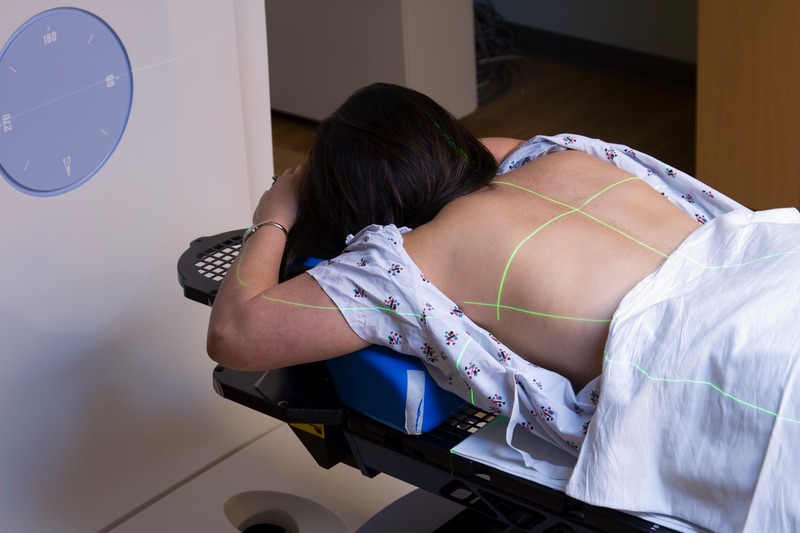
Oncologists treat lung cancer with several different methods, one of which is radiation therapy.
Radiation therapy uses high-energy beams to kill cancer cells. It can be used alone or in combination with surgery, chemotherapy, and/or targeted therapy. How it’s used depends on the type of lung cancer being treated, location and size of the tumor, and the stage of cancer at diagnosis. While not everyone with lung cancer receives radiation therapy as part of the treatment process, it can be used in a few different ways.
Common Types of Radiation Therapy for Lung Cancer
For patients with small cell lung cancer (SCLC) and non-small cell lung cancer, radiation can be delivered with one of several external beam technologies such as:
- Intensity modulated radiation therapy (IMRT) - uses CT scans images of the patient to build the treatment plan so that the beams of radiation can be delivered in various intensities and at very specific angles so that radiation exposure to surrounding healthy tissue is reduced.
- Stereotactic Body Radiation Therapy (SBRT) - used specifically for small, isolated tumors outside the brain and spinal cord, often in the liver or lung.
- Volumetric Modulated Arc Therapy (VMAT) - delivers radiation constantly during the treatment session while the machine rotates around the patient. This allows the beams of radiation to be shaped to the size and form of the tumor.
When Do Lung Cancer Patients Typically Receive Radiation Therapy?
Before starting any treatments the oncology team, including the medical oncologist, radiation oncologist and surgeon, will discuss the best recommendation for treatment based on several factors. Depending on your specific situation, radiation therapy can be given in a few different ways.
Before Surgery to Remove Lung Cancer
If the tumor is rather large, shrinking it with radiation reduces the amount of tissue that needs to be removed during surgery.
As a Primary Treatment Method
Quite often, radiation therapy is used in combination with chemotherapy as one of the primary treatment methods. This is especially the case when the tumor is hard to reach with surgery, or if surgery isn’t an option for the patient.
After Surgery to Remove Lung Cancer
In some cases, the oncologists will recommend radiation therapy after surgery to be sure all of the cancer cells in the area have been killed.
To Treat Lung Cancer in Distant Areas of the Body
If lung cancer has spread to other areas of the body such as the brain or the bones, these areas will be treated as lung cancer using radiation therapy to shrink the lesions in these areas. In these cases, radiation may be used to treat pain caused by cancer or other issues such as bleeding or difficulty swallowing.
Lung Cancer Radiation Therapy Side Effects
If radiation therapy is recommended as part of the treatment process, the oncologists have determined that the potential side effects are outweighed by the benefit it can provide.
Side effects of radiation therapy may be noticeable during treatment, and in some cases, after treatments are complete. Talk to the radiation oncologist and the technicians about how you’re feeling. They can help you address most side effects such as:
- Fatigue
- Skin changes (redness or peeling due to radiation exposure)
- Dizziness
- Nausea or vomiting
- Loss of appetite
- Hair loss in the area of the body where treatment is being given
Preparing for Your First Radiation Oncology Appointment
Before you meet with your radiation oncologist for your first appointment, you’ll need to have a few critical pieces of information available.
- Know your medications. It’s important that the radiation oncologist has an updated list of all the medications you’re taking and any vitamin or herbal supplements. This will help ensure no potential interactions between your prescriptions and radiation therapy treatments or side effects that might arise from treatment.
- Recent scans or tests showing the current condition of your cancer. More images may be necessary, but these scans help the radiation oncologist start their treatment planning process.
Choosing the Right Radiation Oncologist for Lung Cancer Treatment
Sometimes your medical oncologist will suggest you go to a radiation oncologist they know. It’s important to do your own research about the radiation oncologist, the technologies available at the practice, and the convenience of the location. You’re going to have an appointment approximately 5 days a week for 4-6 weeks for radiation therapy. Make sure it’s easy to get there, park and get into the building.
If you or someone you love has received a lung cancer diagnosis in the Greater Atlanta area, we hope you’ll consider one of our radiation centers located in Decatur, Snellville, Covington, and Conyers. Our experienced radiation oncologists care for lung cancer patients every day and can provide you with a radiation treatment plan for your consideration. Contact us for an appointment. Your health and your future are at stake! We’re happy to provide second opinions as well.




